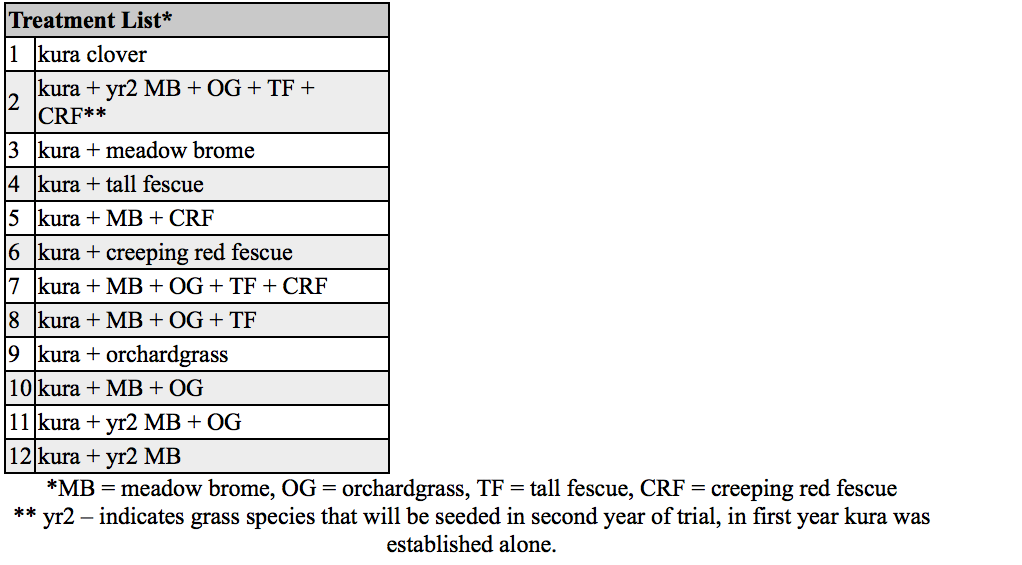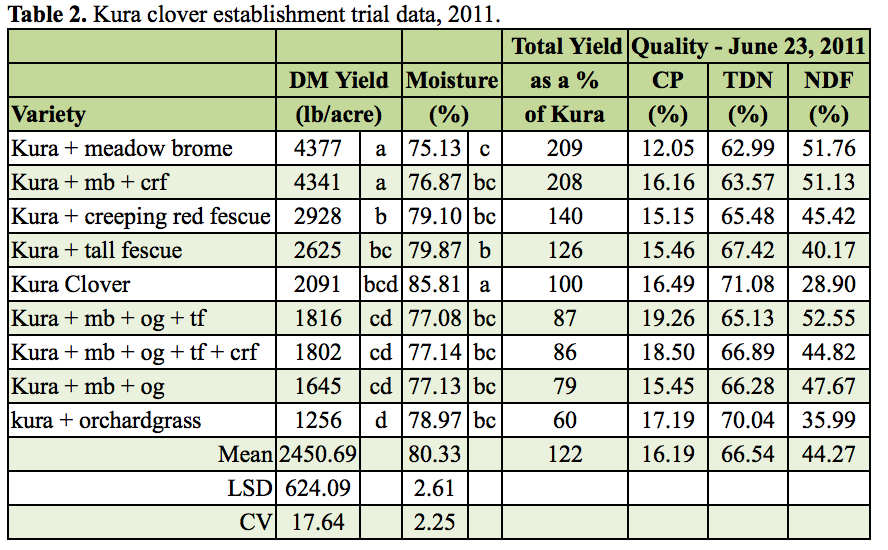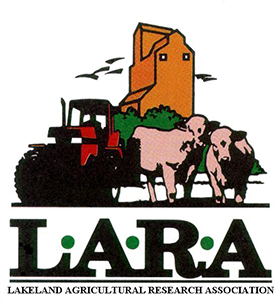Kura Clover Establishment
Kura clover is a long-term perennial clover from the Caucasian mountain region of Russia, the Crimea, Ukraine, eastern Turkey and northern Iran. Sometimes called the 20 year clover it has a large tap root and rhizome system that can reach over 1 meter in diameter within two years. These roots allow Kura to resist drought, short-term flooding, frost, grazing, etc.
This root system also causes its biggest problem, slow establishment. In the first year kura puts most of its energy into root development making it poorly competitive with other plants and difficult to establish. The saying is: “The first year kura sleeps, in the second year it creeps and the third year, it leaps.”
Pure stands of kura clover produce 3 to 4.5 ton/acre of dry matter per year and ideally can be grazed multiple times per year. In a two cut system in Edmonton kura averaged 17.6% CP, on a three cut system 19.5% CP and 22.4% CP when cut four times per year.
Kura is recommended as a pasture legume, its stature making is difficult for hay and silage. It can be mixed with other forages but establishment is more difficult. Previous trials have found better kura establishment if grasses were seeded four weeks after the kura clover. Also better success was achieved when grasses were seeded at half their recommended rates.
Well-adapted to Western Canada, kura likes clay and clay-loam soils and has greater productivity in cool rather than warm climates. Its natural range has made it widely adaptable and kura occurs in poorly drained lowlands to meadows at 3200 metres in the mountains. It survives better than red and white clover in wet soils and can survive soils with low pH and phosphorous deficiencies.
The benefits of kura clover as listed by researchers from the University of Alberta are:
- An alternative pasture legume that is persistent under intensive grazing and of high feed value.
- A new high value opportunity crop for Alberta forage seed growers.
- An alternative nectar crop for Alberta honey producers.
- Reduce input cost of applying nitrogen fertilizer in intensely grazed systems.
- Increase pasture carrying capacity.
- Increase economic returns from pastures.
Methods
Kura clover seed was obtained from Viterra in 2009, the trial was not established until 2010 due to low moisture conditions in 2009.
A kura clover plot was established at Fort Kent (NE25-61-05-W4) on June 2, 2010 using the LARA five-row Fabro zero-till drill. The trial was seeded as a complete randomized block design with four replicates. Each plot was 1.5m by 7.5m.
There were 12 treatments used in this trial; kura clover established alone, kura clover established in mixtures with various grass species and kura clover established alone in first year and then various grass species and mixtures added in year two (table 1).
All plots were seeded with kura clover inoculant and 50 lbs/acre of 11-52-0-0, plots that included grass species also received 125 lbs/acre of 30-11-7-4. Plots were sprayed prior to seeding with 2L/acre of glyphosate and were seeded 0.5 inches deep.
No harvest data was collected for the establishment year. There were some weed issues in the plots with broad-leaf weeds (white cockle, narrow-leafed hawksbeard, chickweed). These plots were hand-weeded once in 2010 and once in 2011.
In 2011 these plots were harvested with the LARA forage harvester on June 23, 2011. Plot weight was recorded and samples were taken, weighed, dried and re-weighed to determine dry matter content.
Table 1. Kura clover trial treatment list.

Comments
The kura clover established well in 2010. While the kura clover started slow and took a long time to get going, it had large leaves and good production by the end of the growing season. The slow start did create some weed issues in these plots. Some weeding was done as there were no spray options.
The plots started well in 2011 and the first harvest occurred in June with lots of growth (Table 2). However, re-growth was much poorer than expected. Cut kura plots grew back slowly and very pale green, indicating a fertility issue. It seems like the inoculant did not work. The kura inoculants was ordered from the states in 2009 when the seed was acquired. The inoculant was sourced provincially by the forage and research association participating in trying kura. This inoculant was then kept over to 2010 when the LARA plots were established and this may have been too long of a shelf-life for it to remain effective. Plants will be checked for nodulation in the spring of 2012.
After further discussion with researchers previously studying kura clover it was decided not to establish kura clover in the year 2 plots. Previous work had established kura in one direction and different grass mixture perpendicular in two separate seeding passes. Because the LARA trial was not established this way trying to seed the grasses into the same seed row was expected to cause too much damage to the kura plants.
Before these fertility issues kura was showing good potential as a pasture legume for the LARA area. The kura did establish well, although first year growth is slow. The higher yielding plots had similar production to the LARA WFT alfalfa plots and a second cut was anticipated based on the early 2011 growth. The plots also showed high feed quality.
Kura mixed with meadow brome and kura mixed with meadow brome and creeping red fescue both showed good potential as pasture mixes. The plots containing orchardgrass seemed to do poorer than the other plots; this may have been an issue with the orchardgrass seed or with competition as the WFT orchardgrass plots also established in 2010 at LARA did very well in 2011.
Table 2. Kura clover establishment trial data, 2011.

To read more about Perennial Forage, click here.
Resources:
Walker, J. and J. King. 2008. Kura Clover. University of Alberta.

